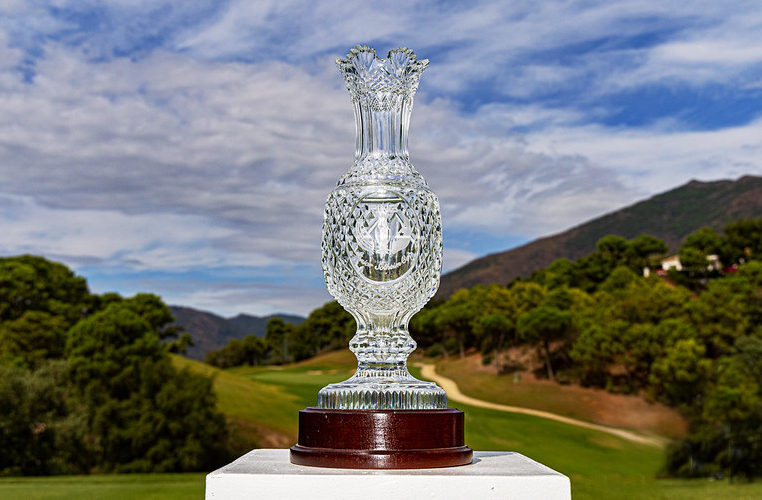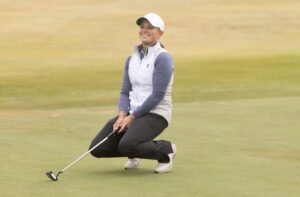Written by Steve Eubanks for the LPGA
It was a woman’s idea: a woman of substance who through kindness, devotion, and the kind of quiet leadership that has faded like a weathered photograph drove a hobby into a business, a business into an enterprise and an enterprise into a legacy.
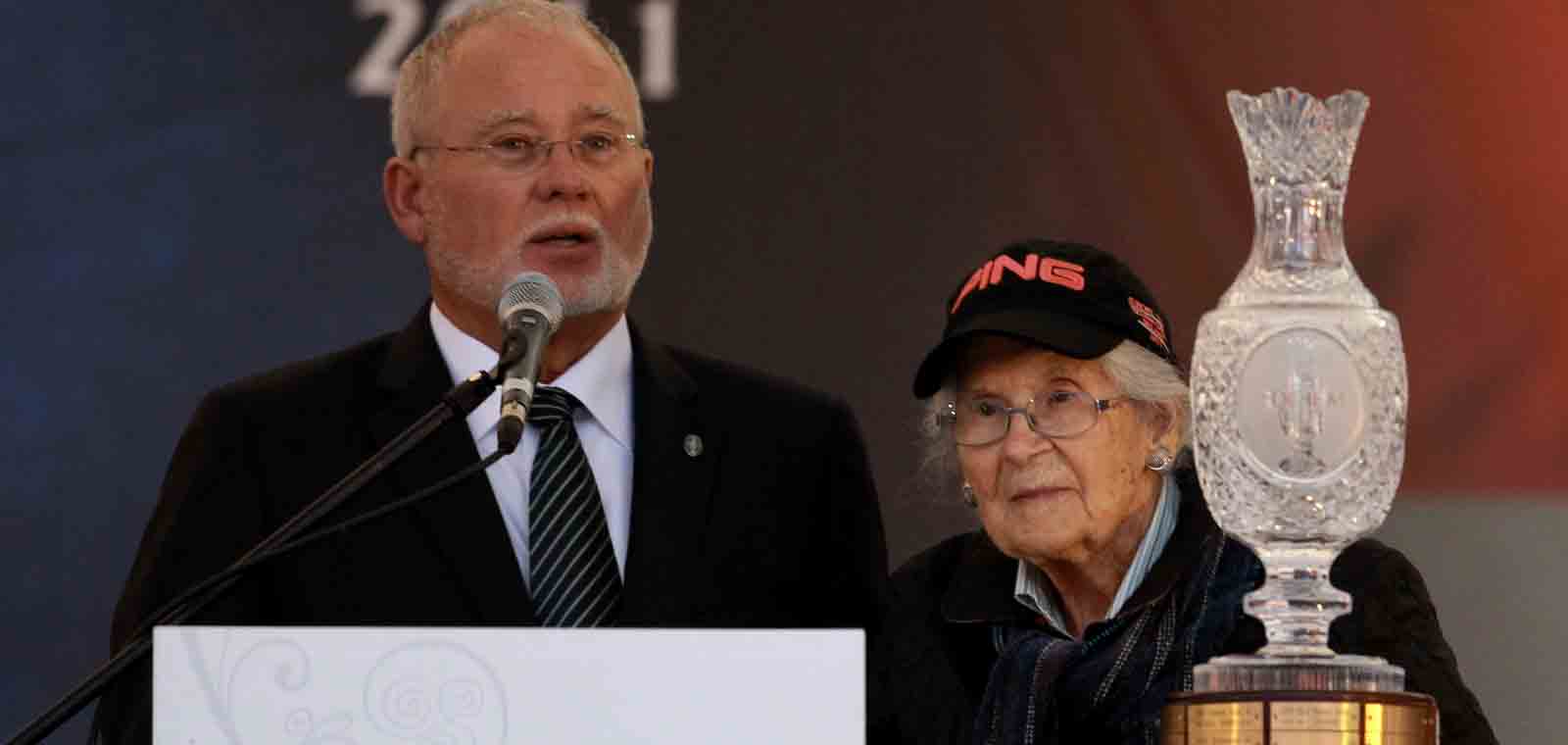
John Solheim the CEO of Ping and Louise Solheim, the widow of Karsten Solheim speak at the closing ceremony on day three of the 2011 Solheim Cup at Killeen Castle Golf Club on September 25, 2011 in Dunshaughlin, County Meath, Ireland. (Photo by Ian Walton/Getty Images)
Louise Solheim’s name will be brought up often this week at the 18th playing of the biennial event that carries the family’s name. Her youngest child, John, has been an omnipresent figure at every playing, and her grandchildren, including John’s son, John K., the current CEO of Ping, are on-site in Spain, continuing the family tradition that traces back to one of the seminal female figures in the history of the game – a woman who never played a round until she was in her 50s, but whose presence is felt with every shot struck in the Solheim Cup.
You cannot appreciate the history of this event without understanding the woman who gave it her nod of approval. Louise Solheim was born in 1918 in Spokane, Washington. When she was an infant, her mother died of scarlet fever, a disease that, while still around, seems ancient in today’s world. Like many children who lose a parent young, Louise overachieved at everything. She was a mathematics and science standout at a time when such studies were deemed unladylike. But she found her soulmate, a man of equal intellect and extreme moral fiber, at a church function. It was there that Louise saw a handsome, curly-haired man in the choir loft leading a group of adolescent boys. He was a local shoemaker and Norwegian immigrant named Karsten Solheim. They were married six months later. Louise was 18. Karsten was 24.
Her granddaughter described her as, “humble, brilliant, shrewd, beautiful, elegant, and kind. And she was a good problem-solver. She would help you figure out what to do yourself and once a decision was made, she would assist you in your decision, however she was able.”
Louise worked at Convair, Lockheed Aircraft (now Lockheed Martin Aerospace) and Cornell University’s College of Engineering, but never when her four children were young. Family always came first. So, when Karsten, who had been transferred to Phoenix by General Electric in the 60s, started building putters in their garage, Louise handled the business side of things, even going back to school to learn about international taxes, shipping and supply chains. She even named what turned out to be Karsten’s most famous design, a beryllium copper putter with an offset head and the weight distributed in the heel and toe. “Call it the Answer,” Louise told her husband.
Karsten said, “That won’t fit in the allotted space.”
“Well,” Louise answered with her typical calm, “Maybe you could drop the ‘W’.”
Dignified and supportive, Louise took a similar approach in 1990 when an idea came up for a biennial women’s professional match-play event between Europe and the United States.
The PGA of America and DP World Tour had the Ryder Cup, and the USGA and R&A hosted the Walker Cup and the Curtis Cup, matches between amateur men and women from the U.S. and Great Britain and Ireland. But there was no similar showcase for women professionals. Karsten was the embodiment of the American dream, born in Bergen, Norway to parents who sailed to Seattle when he was two. Through innovation, faith, family, countless hours and gallons of sweat, Karsten had become an icon in a game he didn’t play until age 43.
“We could do this,” Louise suggested at the match-play idea. That was all she needed to say. The Solheim Cup was born.
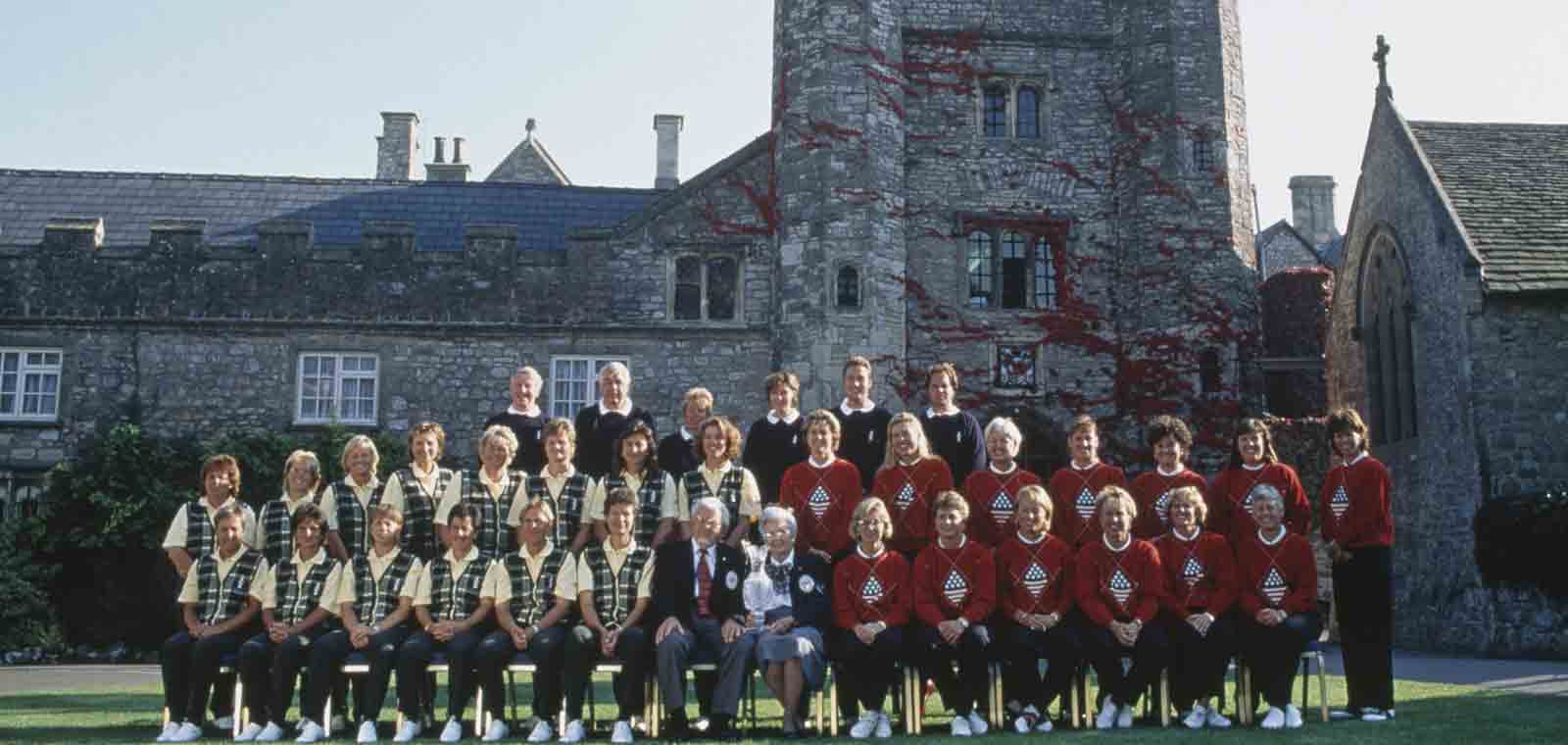
The European (left) and American teams at the St. Pierre Hotel & Country Club, Chepstow, Wales, during the Solheim Cup golf tournament, 20th-22nd September 1996. With them (front, centre) are the tournament’s co-founder, Karsten Solheim (1911 – 2000) and his wife, Louise, with the trophy. (Photo by Stephen Munday/Getty Images)
That fall, at a fairly new golf course on Lake Nona, in a remote part of Orlando where cows outnumbered cars two to one, the Solheim Cup launched in front of a smattering of fans. Galleries were small by today’s standards, but they exceeded expectations at the time.
By then the LPGA Tour had gained a foothold with an American television audience. Stars like Nancy Lopez, Betsy King and Beth Daniel were attracting more eyeballs to the women’s professional game. But there were also some well-known Europeans competing in the States. The 1987 and 1988 U.S. Women’s Opens had been won by England’s Laura Davies and Liselotte Neumann from Sweden, respectively. Pam Wright from Scotland was also the 1989 Louise Suggs Rolex Rookie of the Year.
That first U.S. team, captained by the legendary Kathy Whitworth, included Lopez, King and Daniel as well as Pat Bradley, Patty Sheehan, Cathy Gerring, Dottie Pepper and Rosie Jones. There were only eight players per side at the time, and only one set of matches per day.
The European team consisted of Davies, Neumann and Wright plus Dale Reid, Trish Johnson, Helen Alfredsson (who would go on to capture the Rookie of the Year title in 1992), France’s Marie-Laure de Lorenzi and future U.S. Women’s Open champion Alison Nicholas of Gibraltar.
As expected, the U.S. won handily, taking the Solheim Cup 11½ to 4½. “I couldn’t be more pleased to be a part of history right here in Orlando with the first playing of the Solheim Cup,” Bradley said afterward.
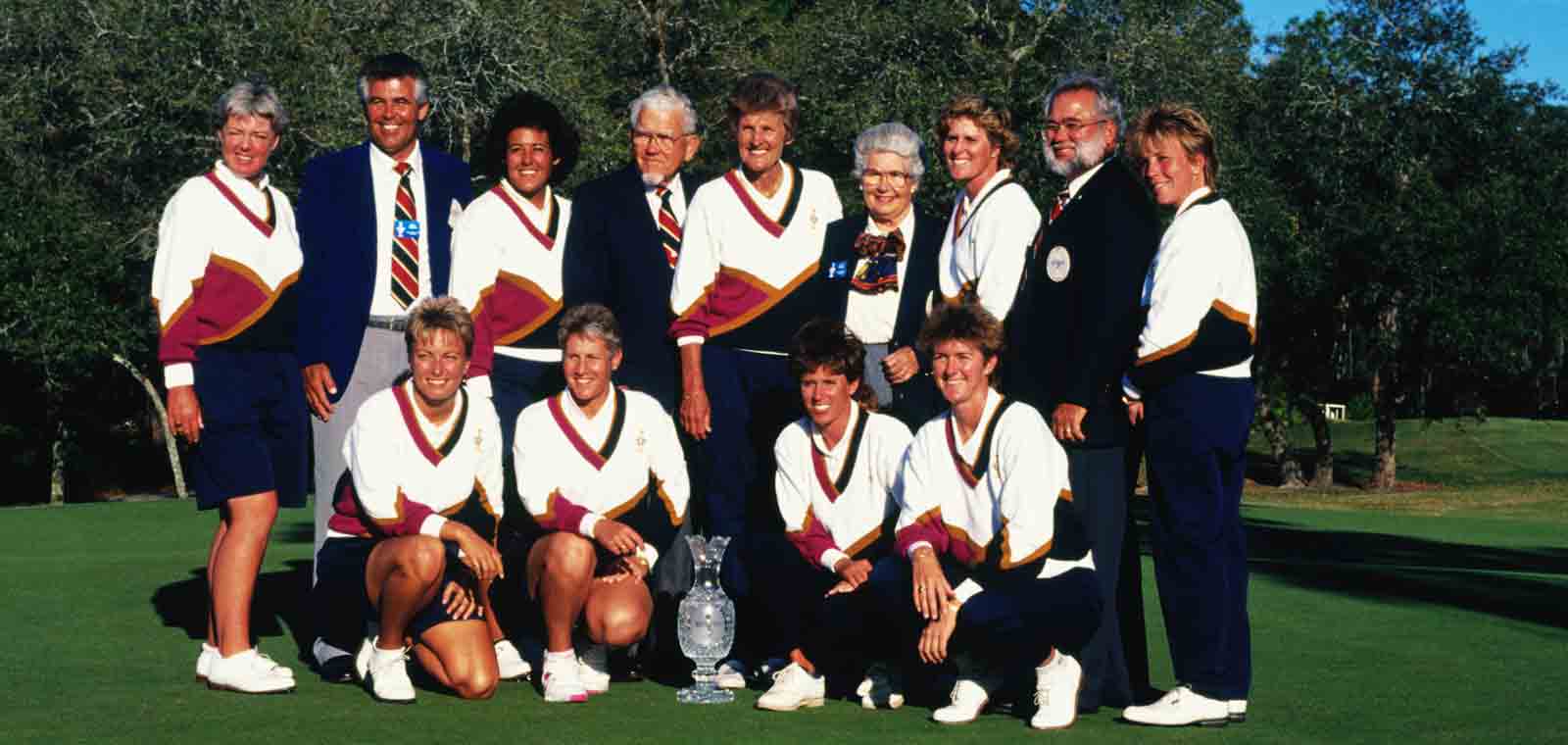
1990 The victorious USA team with the Solheim family after the Solheim Cup in 1990 at the Lake Nona Golf Club in Florida, USA. (Photo By Stephen Munday/Getty Images)
“It’s important to remember what an impact the first Solheim Cups had on the development of the LET and global women’s golf,” said Alexandra Armas, the CEO of the Ladies European Tour. “That first European squad faced a United States team that was full of experienced Hall of Famers, whom the younger European players admired and looked up to. To be expected, America came out on top on that occasion. However, two years later, in 1992, that same group of Europeans, plus Catrin Nilsmark, Kitrina Douglas and Florence Descampe, upset the Americans and won the Solheim Cup at Dalmahoy in Scotland.
“That demonstrated to many of the Europeans that they belonged on the world stage and proved the catalyst for them to go on to become global major champions and future LPGA stars.
“We have been growing the game around the world ever since.”
The Solheim Cup has gone back and forth in subsequent years. In 1992, the number of players was increased to 10, and by 1996, it was up to 12 on each side, the same as the Ryder Cup. The U.S. won three in a row, 1994, 1996 and 1998 with captains JoAnne Carner and Jody Rankin hoisting the crystal trophy at the end of those weeks. But in 2000 Carin Koch captured the winning point for Europe. With a cold, Scottish rain dripping from her blonde pigtails that jutted from beneath a ski cap like something out of a Viking drama, Koch raised her hands and broke into a smile that was picked up by news outlets all over the world.
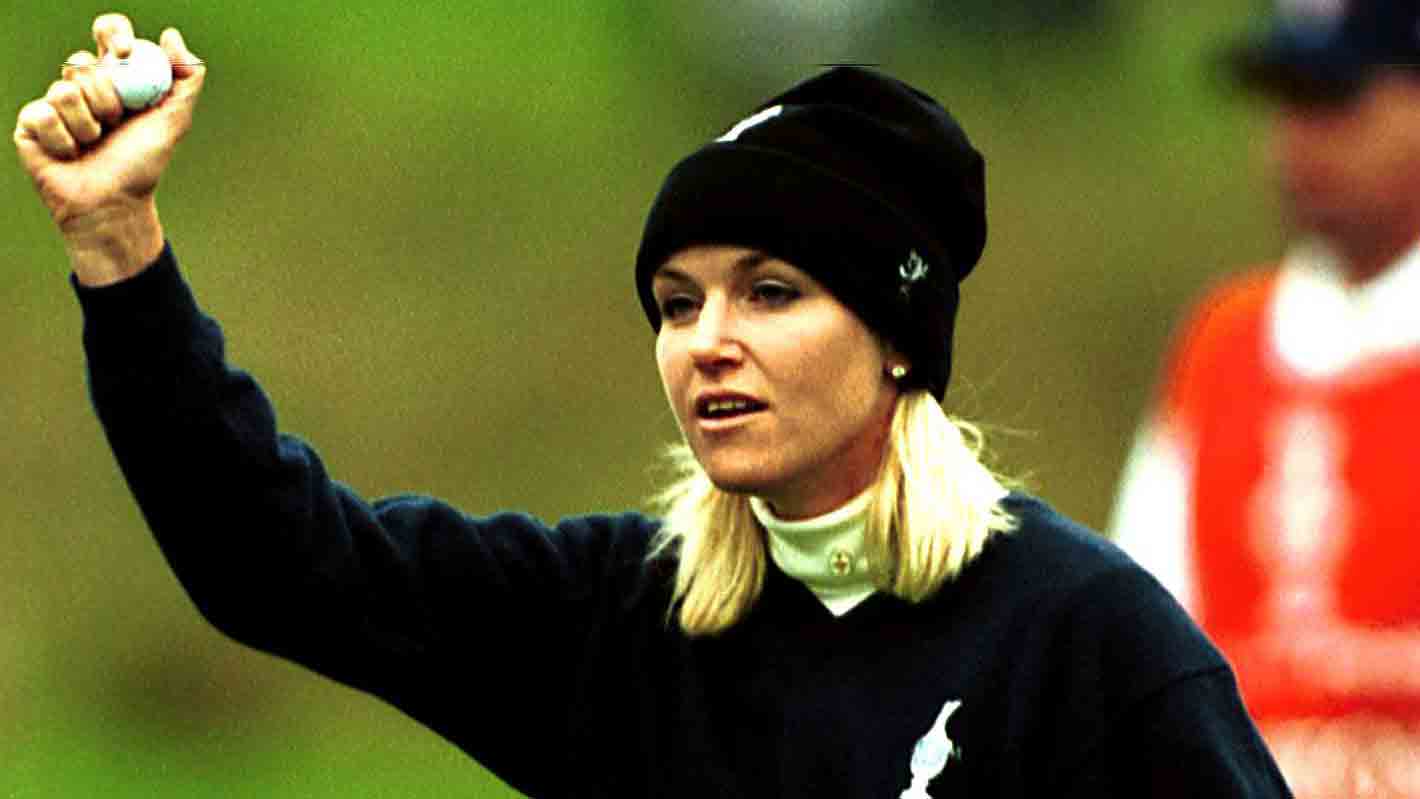
Carin Koch of Europe celebrates during the AM Foursomes match at the Solheim Cup played at the Loch Lomond GC, Loch Lomond, Scotland. Picture: Stuart Franklin. Mandatory Credit: Allsport/ALLSPORT
Just like that, the event that had shown steady growth over the years exploded beyond golf and into the consciousness of the broader sports world.
That 2000 event had a wistfulness to it, though. Karsten Solheim passed away the previous February at age 88. And while his son John had been running the company for some time, the patriarch was sorely missed that week as the mist and rain mirrored the feelings of those who knew him.
He lived to see the event grow and prosper, and would no doubt be thrilled by what it has become today.
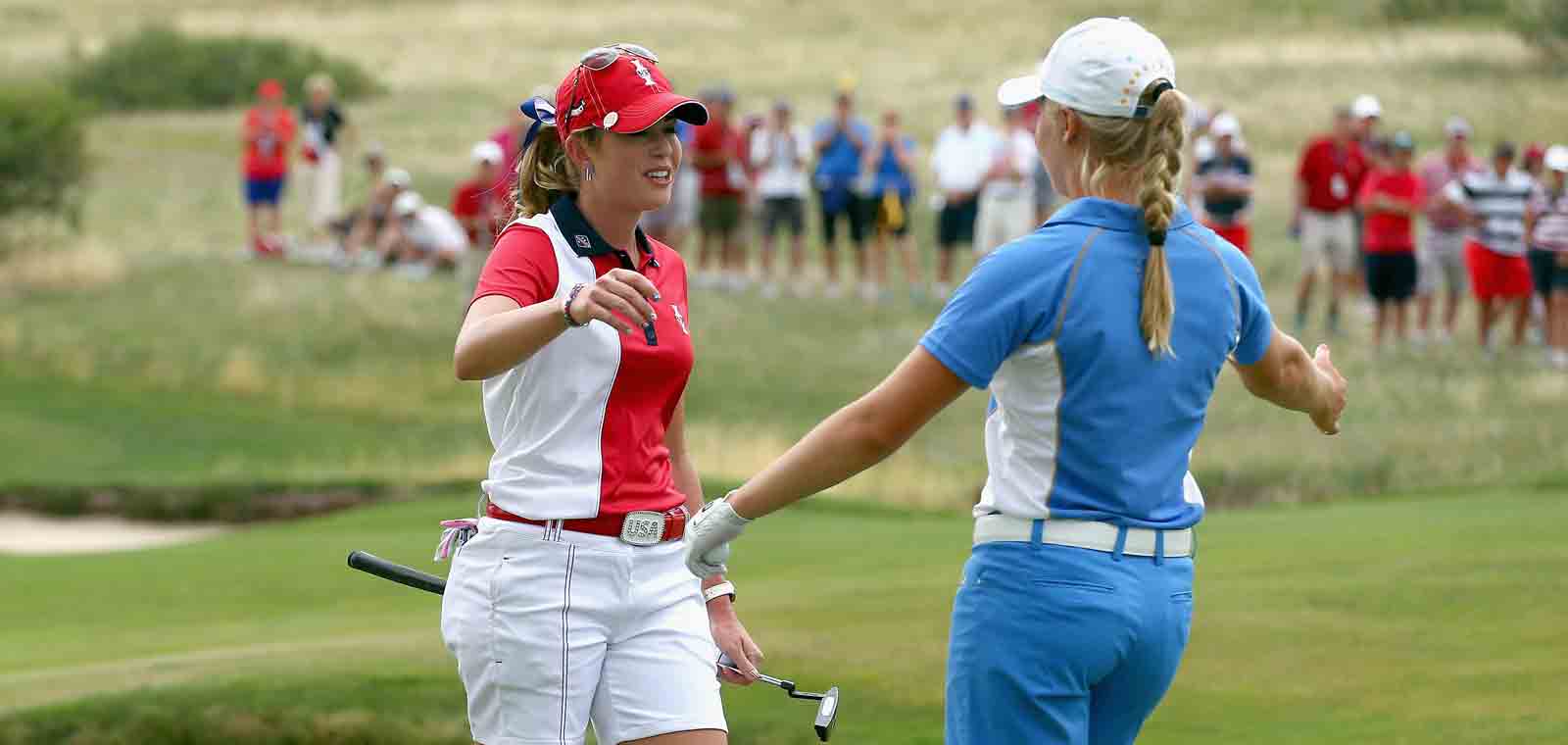
Charley Hull of England and the European Solheim Cup Team and Paula Creamer of the USA Solheim Cup Team hug after Hull won their match during the final day singles matches of the 2013 Solheim Cup at the Colorado Golf Club on August 18, 2013 in Parker, Colorado. (Photo by Andy Lyons/Getty Images)
Venues helped. The Greenbrier, Muirfield Village, Loch Lomond in Scotland, Interlachen in Minnesota, Crooked Stick in Indiana and Killeen Castle in Ireland captured fans’ interests even if the casual observer didn’t know all the players. Throw in the fact that Europe had stars like Annika Sorenstam and Suzann Pettersen going up against equally fiery Americans like Cristie Kerr, Paula Creamer and Morgan Pressel and it was easy to see how the Solheim Cup expanded to become the signature event of the women’s game.
Europe won back-to-back Solheim Cups for the first time in 2011 and 2013, the latter coming at Colorado Golf Club, a Crenshaw/Coore-designed course between Denver and Castle Rock. That week marked the debuts of Gerina Mendoza, an athlete from New Mexico who took up golf late, and Charley Hull, a fearless English teenager from a working-class background.
Neumann, a proud member of that first European Solheim Cup team in 1990, led her squad to the continent’s first victory on American soil. But other than the Sunday dominance of the Europeans, the most memorable moments came when Caroline Hedwall became the first player in Solheim Cup history from either side to win five matches. And, on the lighter side, Hull, who was 17 at the time, thumped Paula Creamer 5 and 4 in singles on Sunday and then asked Creamer for her autograph.
“Yeah, I wasn’t expecting that,” Creamer said at the time. “I signed it, sure. What else was I going to do?”
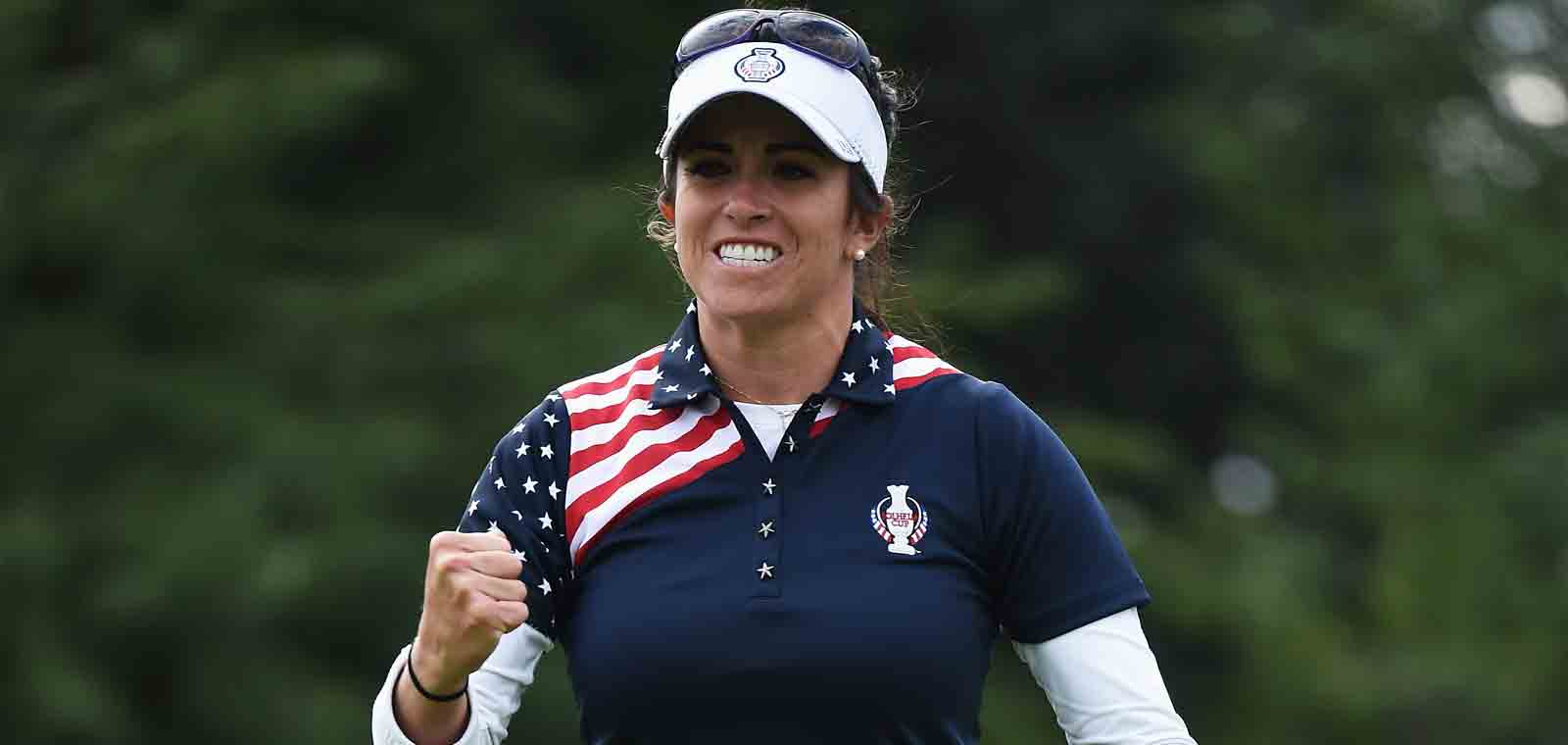
Gerina Piller of team USA celebrates winning her match during the singles matches of The Solheim Cup at St Leon-Rot Golf Club on September 20, 2015 in St Leon-Rot, Germany. (Photo by Stuart Franklin/Getty Images)
American revenge came late on Sunday two years later in a remote part of Germany between Frankfurt and Manheim. That week, a U.S. team led by Captain Juli Inkster rallied in singles for the largest comeback in Solheim Cup history. Trailing 10 – 6 early Sunday morning after the rain-delayed fourball matches ended, the Americans came out blazing, winning eight of the singles matches and halving one more to capture the cup 14½ to 13½.
Mendoza sealed the comeback, holing a downhill nine-footer for par on the final hole to beat Caroline Masson 1 up.
Two years later, the matches in Des Moines, Iowa also began on a melancholy note. Just five weeks before the first shots were fired, Louise Solheim passed away at age 99. She was a stalwart to the end. The things that mattered to her at age 18 – family, faith, and the continued integrity of everything that carried the Solheim name – remained her focus until she slipped away to reunite with her husband in the summer of 2017.
Together again, the Solheims saw one of the finest displays of match-play golf in history as the U.S. routed Europe 16½ to 11½. And the Europeans did not play badly. In the Friday afternoon fourball matches, Captain Annika Sorenstam’s European team carded 36 birdies and an eagle. They lost the session 4 – 0.
“It was amazing golf,” Sorenstam said afterward. “Obviously, we wanted a different outcome, but to see that level of golf being played…it was amazing.”
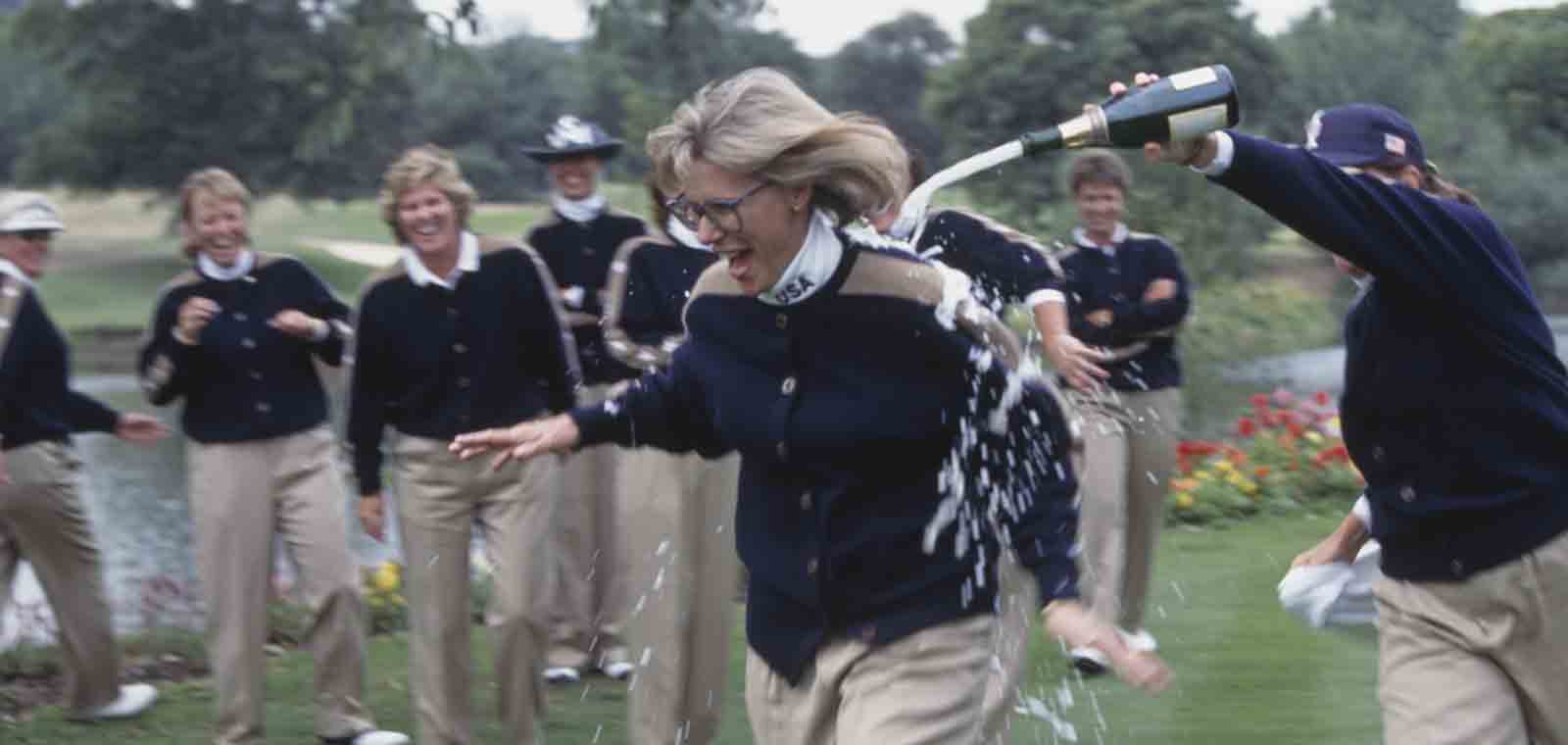
Judy Rankin, the non-playing captain of the United States team is doused with champagne as her players celebrate retaining the cup at the Solheim Cup golf tournament at St. Pierre Hotel & Country Club, Chepstow, Wales, 22nd September 1996. (Photo by David Cannon Collection/Getty Images)
If only she had known what was coming.
Stung by the back-to-back losses and trailing going into the final day in the chilly air of the Scottish Highlands in September of 2019, Suzann Pettersen put a capstone on the most watched women’s sporting event in Scotland’s history. Pettersen made a birdie putt on the final green at Gleneagles to capture the closest Solheim Cup in history.
The Norwegian star and American Marina Alex were the last match on the course that Sunday. If Pettersen missed her birdie, the U.S. would retain the Cup. But she poured the six-footer into the middle of the hole, then dropped her putter to the ground and let out a roar that echoed all the way to Edinburgh.
Moments later, holding her son, Herman, in her arms, Pettersen authored one of the great walk-off moments in sports history by retiring on the spot. She made the announcement on Golf Channel and confirmed it later to an expectant media.
It was a fitting end to a momentous week.
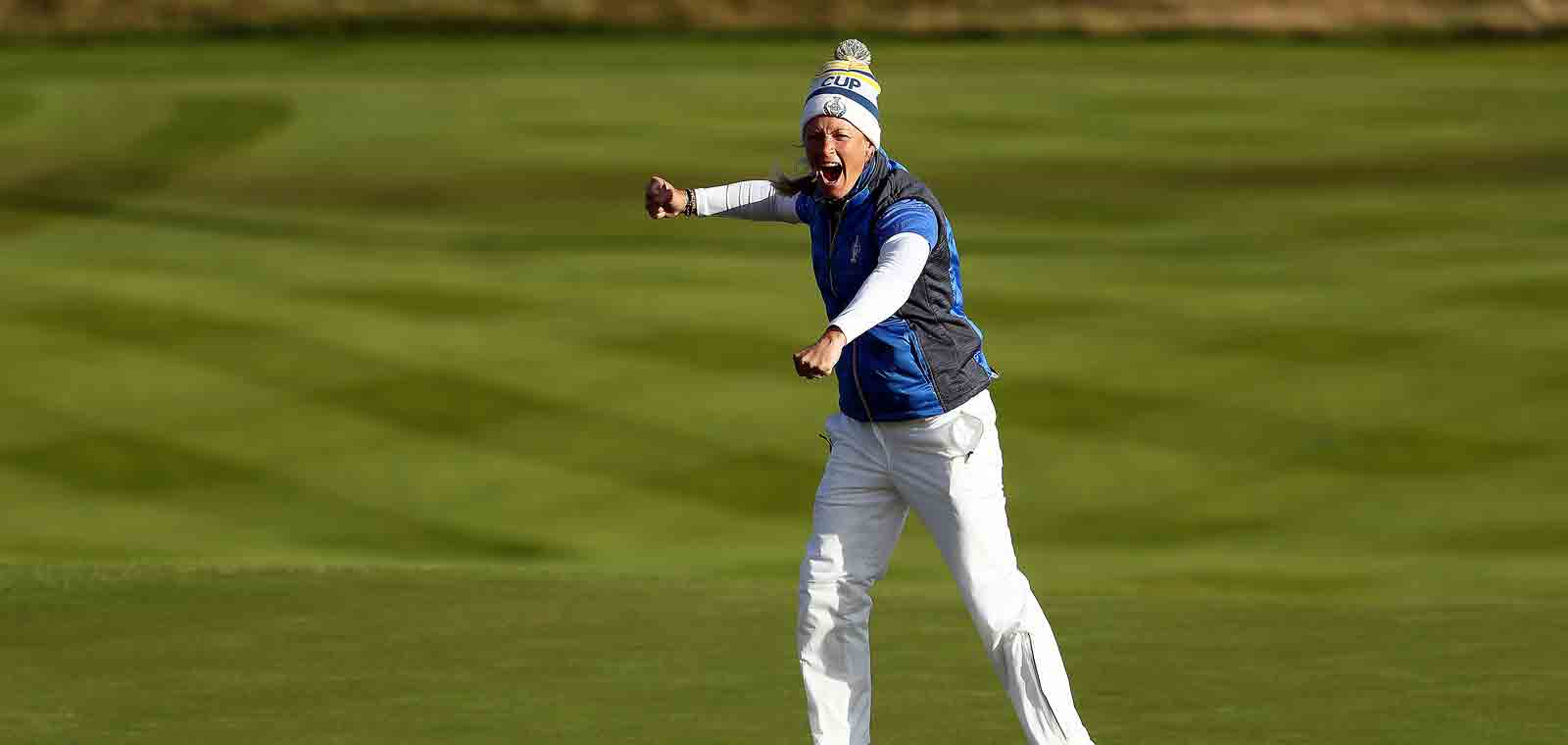
Suzann Pettersen of Team Europe celebrates making her final putt on the 18th hole as Europe wins the Solheim Cup during the final day singles matches of the Solheim Cup at Gleneagles on September 15, 2019 in Auchterarder, Scotland. (Photo by Jamie Squire/Getty Images)
Europe kept the steak alive by winning back-to-back for a second time at Inverness Club in Toledo, Ohio in 2021. That week, the breakout star was Leona Maguire, who won 4½ points to lead all players and provide an emotional boost to her team.
“It means so much,” Maguire said afterward. “You dream about moments like this from the time you start playing and for it to happen with these teammates, it’s really special.”
More special moments await as the Solheim Cup begins on Friday at Finca Cortesin in Andelusía, Spain.
Since 2000, the matches are tied 6 – 6 and each outcome seems close and more competitive than the last.
As always, the Solheims will be there, walking the first tee, greeting players, welcoming everyone with open arms, and sharing their time and talents with fans from around the globe.
Louise and Karsten are no doubt watching and smiling. The legacy they worked so hard to create remains in good and steady hands.
 Lisa Hackney of Europe celebrates with her caddie during the Solheim cup at St. Pierre golf course in Chepstow, Wales. Mandatory Credit: Stephen Munday/ALLSPORT
Lisa Hackney of Europe celebrates with her caddie during the Solheim cup at St. Pierre golf course in Chepstow, Wales. Mandatory Credit: Stephen Munday/ALLSPORT




